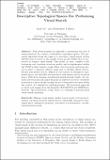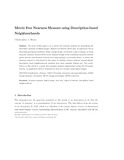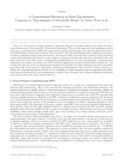Department of Applied Computer Science: Recent submissions
Now showing items 1-20 of 24
-
Multimedia Forensics: Preserving Video Integrity with Blockchain
(IEEE, 2024)This paper addresses some of the challenges of video forgery detection in multimedia forensics. It presents a solution that enhances video verification by utilizing the non-alterable features of blockchain technology and ... -
Dynamic Calculation of Password Salts for Improved Resilience towards Password Cracking Algorithms
(IEEE, 2024)Passwords have been an integral part of our lives from the dawn of the internet and keeping them secure has been of paramount importance. Each attempt to secure our digital lives has been met with increased complexity and ... -
Fusarium head blight detection, spikelet estimation, and severity assessment in wheat using 3D convolutional neural networks
(Canadian Science Publishing, 2024-04-10)Fusarium head blight (FHB) is one of the most significant diseases affecting wheat and other small-grain cereals worldwide. Developing FHB-resistant cultivars is critical but requires field and greenhouse disease assessment, ... -
Cryptographic Techniques for Data Privacy in Digital Forensics
(IEEE, 2023-12-15)The acquisition and analysis of data in digital forensics raise different data privacy challenges. Many existing works on digital forensic readiness discuss what information should be stored and how to collect relevant ... -
A comprehensive review of 3D convolutional neural network-based classification techniques of diseased and defective crops using non-UAV-based hyperspectral images
(Elsevier B.V., 2023-09-14)Hyperspectral imaging (HSI) is a non-destructive and contactless technology that provides valuable information about the structure and composition of an object. It has the ability to capture detailed information about the ... -
Inside out: transforming images of lab-grown plants for machine learning applications in agriculture
(Frontiers, 2023-07-06)Machine learning tasks often require a significant amount of training data for the resultant network to perform suitably for a given problem in any domain. In agriculture, dataset sizes are further limited by phenotypical ... -
Leveraging Guided Backpropagation to Select Convolutional Neural Networks for Plant Classification
(2022-05-11)The development of state-of-the-art convolutional neural networks (CNN) has allowed researchers to perform plant classification tasks previously thought impossible and rely on human judgment. Researchers often develop ... -
3D Convolutional Neural Networks for Solving Complex Digital Agriculture and Medical Imaging Problems
(University of WinnipeUniversity of Winnipeg, 2022-06)3D signals have become widely popular in view of the advantage they provide via 3D representations of data by employing a third spatial or temporal dimension to extend 2D signals. Predominantly, 3D signals contain details ... -
Descriptive Topological Spaces for Performing Visual Search
(Springer, 2019-02-02)This article presents an approach to performing the task of visual search in the context of descriptive topological spaces. The presented algorithm forms the basis of a descriptive visual search system (DVSS) that is based ... -
A Descriptive Tolerance Nearness Measure for Performing Graph Comparison
(IOS Press, 2018-11-03)This article proposes the tolerance nearness measure (TNM) as a computationally reduced alternative to the graph edit distance (GED) for performing graph comparisons. The TNM is defined within the context of near set theory, ... -
An embedded system for the automated generation of labeled plant images to enable machine learning applications in agriculture
(PLOS, 2020-12-17)A lack of sufficient training data, both in terms of variety and quantity, is often the bottleneck in the development of machine learning (ML) applications in any domain. For agricultural applications, ML-based models ... -
Signature-based perceptual nearness: Application of near sets to image retrieval
(Birkhäuser, 2013)This paper presents a signature-based approach to quantifying perceptual nearness of images. A signature is defined as a set of descriptors, where each descriptor consists of a real-valued feature vector associated with a ... -
Quantifying nearness in visual spaces
(Taylor & Francis, 2013)Cybernetic vision systems can be deployed in problem domains where the goal is to achieve results similar to those produced by humans. Fundamentally, these problems consist of evaluation of image content between sets of ... -
Perception-based image classification: Framework for perception-based cybernetics
(Emerald Insight, 2010-08-24)Purpose: The purpose of this paper is to present near set theory using the perceptual indiscernibility and tolerance relations, to demonstrate the practical application of near set theory to the image correspondence problem, ... -
Neighbourhood-based vision systems
(Taylor and Francis, 2011)The problem presented in this paper is how to find similarities between digital images useful in design cybernetic vision systems. The solution to this problem stems from a neighbourhood based vision system. A neighbourhood ... -
Metric free nearness measure using description-based neighbourhoods
(Springer, 2013-02-26)The focus of this paper is on a metric free nearness measure for quantifying the descriptive nearness of digital images. Regions of Interest (ROI) play an important role in discerning perceptual similarity within a single ... -
Measuring the nearness of layered flow graphs: Application to Content Based Image Retrieval
(IOS Press, 2016-03-01)Rough set based flow graphs represent the flow of information for a given data set where branches of these could be constructed as decision rules. However, in the recent years, the concept of flow graphs has been applied ... -
Automated LULC Map Production using Deep Neural Networks
(Taylor & Francis, 2019-01-17)This article presents an approach to automating the creation of land-use/land-cover classification (LULC) maps from satellite images using deep neural networks that were developed to perform semantic segmentation of natural ... -
A Deep Learning Framework: Land-Use/Land-Cover Mapping and Analysis using Multispectral Satellite Imagery
(Springer, 2019-07-17)In this article, we present an approach to land-use and land-cover (LULC) mapping from multispectral satellite images using deep learning methods. The terms satellite image classification and map production, although used ...




















